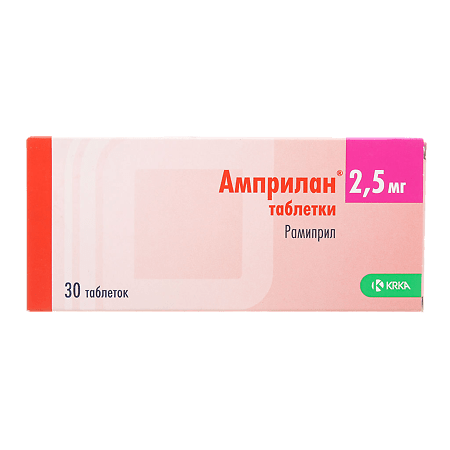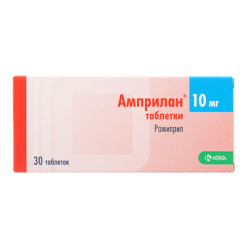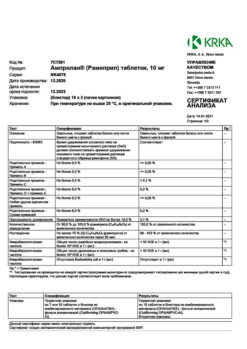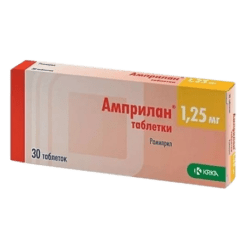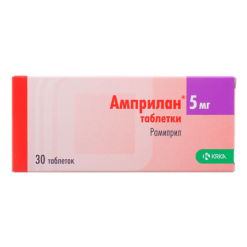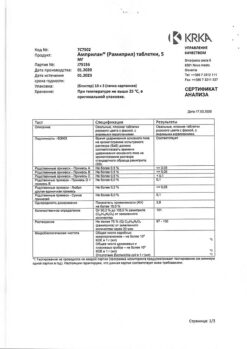No products in the cart.
Amprilan, tablets 2,5mg 30 pcs
€11.26 €9.85
Description
Pharmacotherapeutic group:
Angiotensin-converting enzyme (ACE) inhibitor
ATX code: C09AA05
Pharmacological properties
Pharmacodynamics
The active metabolite of ramipril formed by “hepatic” enzymes, ramiprilate, is a long-acting ACE inhibitor (synonyms ACE: kininase II, dipeptidylcarboxydipeptidase I). ACE in blood plasma and tissues catalyzes the conversion of angiotensin I into angiotensin II, which has a vasoconstrictor effect, and the breakdown of bradykinin, which has a vasodilator effect.
Therefore, when ramipril is taken orally, angiotensin II formation is reduced and bradykinin accumulates, resulting in vasodilatation and a decrease in blood pressure (BP).
The increase of activity of kallikrein-kinin system in plasma and tissues with activation of prostaglandin system and increase of synthesis of prostaglandins that stimulate formation of nitric oxide (N0) in endotheliocytes cause its cardioprotective action.
Angiotensin II stimulates production of aldosterone; therefore, taking ramipril results in decreased secretion of aldosterone and increased serum potassium.
When plasma concentrations of angiotensin II are reduced, its negative feedback inhibitory effect on renin secretion is eliminated, resulting in increased plasma renin activity.
It is assumed that the development of some adverse reactions (in particular, “dry” cough) is associated with increased bradykinin activity.
In patients with arterial hypertension, ramipril administration leads to a decrease in BP in the supine and standing position without a compensatory increase in heart rate (HR).
Ramipril significantly reduces total peripheral vascular resistance (TPR) with little or no change in renal blood flow and glomerular filtration rate. Antihypertensive effect begins to appear 1 to 2 hours after oral administration of a single dose of the drug, reaching the greatest value after 3-6 hours, and lasts for 24 hours.
When taking Amprilan as a course, the antihypertensive effect may increase gradually, stabilizing usually by 3-4 weeks of regular use and then persisting for a long time. Sudden discontinuation of the drug does not lead to a rapid and significant increase in BP (no “withdrawal” syndrome).
In patients with arterial hypertension, ramipril slows the development and progression of myocardial and vascular wall hypertrophy.
In patients with chronic heart failure (CHF), ramipril decreases PEEP (decreases afterload on the heart), increases venous capacity and decreases left ventricular (LV) filling pressure, which consequently leads to a decrease in cardiac preload. In these patients, ramipril administration has increased cardiac output, LV ejection fraction (LVEF) and improved exercise tolerance.
In diabetic and nondiabetic nephropathy, taking ramipril slows the rate of progression of renal failure and time to end-stage renal failure and thus reduces the need for hemodialysis or renal transplantation.
In the initial stages of diabetic or nondiabetic nephropathy, ramipril reduces the incidence of albuminuria.
. In patients at high risk of cardiovascular disease due to vascular lesions (diagnosed coronary heart disease, history of peripheral arterial obliterative disease, history of stroke) or diabetes with at least one additional risk factor (microalbuminuria, arterial hypertension, increased concentration of total cholesterol (TC), decreased concentration of high-density lipoprotein cholesterol (HDL-C), smoking) the addition of ramipril to standard therapy reduces the incidence of myocardial infarction, stroke and mortality from cardiovascular causes.
In addition, ramipril reduces overall mortality and the need for revascularization procedures and slows the onset or progression of CHF.
. In patients with heart failure with clinical manifestations that developed during the first days of acute myocardial infarction (days 2-9), ramipril administration started from day 3 to day 10 of acute myocardial infarction reduced mortality (by 27%), risk of sudden death (by 30%), risk of progression of heart failure to severe (NYHA functional class III-IV)/resistant to therapy (by 23%), the likelihood of subsequent hospitalization due to the development of heart failure (by 26%).
In the general patient population, as well as in patients with diabetes mellitus, both with arterial hypertension and with normal BP, ramipril reduces the risk of nephropathy and microalbuminuria.
Pharmacokinetics
After oral administration, ramipril is rapidly absorbed from the gastrointestinal tract (50 – 60%). Food intake slows its absorption but does not affect the completeness of absorption.
Ramipril undergoes intensive presystemic metabolism/activation (mainly in the liver by hydrolysis) resulting in the formation of its only active metabolite, ramiprilate, which has approximately 6 times greater activity with respect to ACE inhibition than ramipril.
In addition, metabolism of ramipril produces diketopiperazine, which has no pharmacological activity and then undergoes conjugation with glucuronic acid; ramiprilat is also glucuronized and metabolized to diketopiperazine acid.
The bioavailability of ramipril after oral administration ranges from 15% (for 2.5 mg dose) to 28% (for 5 mg dose). The bioavailability of the active metabolite, ramiprilate, after oral administration of 2.5 mg and 5 mg ramipril is approximately 45% (compared to its bioavailability after intravenous administration in the same doses).
After oral administration of ramipril, maximum plasma concentrations of ramipril and ramiprilate are reached after 1 and 2 to 4 hours, respectively.
The decrease in plasma concentrations of ramiprilat occurs in several phases: a distribution and excretion phase with a half-life (T1/2) of ramiprilat of approximately 3 hours, then an intermediate phase with a T1/2 of ramiprilat of approximately 15 hours, and an end phase with a very low plasma concentration of ramiprilat and a T1/2 of ramiprilat of approximately 4-5 days.
This end phase is due to the slow release of ramiprilat from strong binding to ACE receptors. Despite the prolonged end phase when ramipril is taken once daily at a dose of 2.5 mg or more, equilibrium plasma concentrations of ramiprilat are reached after approximately 4 days of treatment.
When administered as a regimen, the “effective” TT/2 is 13 to 17 hours, depending on the dose.
The binding to plasma proteins is approximately 73% for ramipril and 56% for ramiprilat.
After intravenous administration, the volume of distribution of ramipril and ramiprilat is approximately 90 L and approximately 500 L, respectively.
After intravenous administration of radioactive isotope-labeled ramipril (10 mg), 39% of the radioactivity is excreted through the intestine and about 60% through the kidneys. After intravenous administration of ramipril, 50-60% of the dose is detected in the urine as ramipril and its metabolites.
After intravenous administration of ramiprilat, about 70% of the dose is detected in the urine as ramiprilat and its metabolites; in other words, when ramipril and ramiprilat are administered intravenously, a significant portion of the dose is eliminated through the intestine with the bile, bypassing the kidneys (50% and 30%, respectively).
After oral administration of 5 mg of ramipril in patients with bile duct drainage, almost equal amounts of ramipril and its metabolites are excreted by the kidneys and through the intestine during the first 24 hours after administration.
Approximately 80 to 90% of metabolites in urine and bile have been indentified as ramipril and ramiprilate metabolites. Ramipril glucuronide and ramipril diketopiperazine account for approximately 10-20% of the total, and the urinary content of unmetabolized ramipril is approximately 2%. In animal studies, ramipril has been shown to be excreted in maternal milk.
In impaired renal function with a creatinine clearance (CK) of less than 60 ml/min, excretion of ramiprilat and its metabolites by the kidneys is delayed. This leads to increased plasma concentration of ramiprilat, which decreases more slowly than in patients with normal renal function.
When taking ramipril at high doses (10 mg), impaired liver function leads to slower presystemic metabolism of ramipril to active ramiprilate and slower excretion of ramiprilate.
In healthy volunteers and in patients with arterial hypertension after two weeks of treatment with ramipril at a daily dose of 5 mg, there is no clinically significant accumulation of ramipril and ramiprilat. In patients with CHF after two weeks of treatment with ramipril at a daily dose of 5 mg there was a 1.5-1.8-fold increase in plasma concentrations of ramiprilat and area under the “concentration-time curve” (AUC).
In healthy elderly volunteers (65 to 75 years of age), the pharmacokinetics of ramipril and ramiprilat are not significantly different from those of younger healthy volunteers.
Indications
Indications
Arterial hypertension (in monotherapy or in combination with other antihypertensive drugs, for example, diuretics and blockers of “slow” calcium channels).
Chronic heart failure (as part of combination therapy, in particular in combination with diuretics).
Diabetic nephropathy or non-diabetic nephropathy, preclinical and clinically pronounced stages, including with severe proteinuria, especially when combined with arterial hypertension.
Reducing the risk of myocardial infarction, stroke, or cardiovascular mortality in patients at high cardiovascular risk:
in patients with confirmed coronary heart disease, a history of myocardial infarction or without it, including patients who have undergone percutaneous transluminal coronary angioplasty, coronary artery bypass grafting;
in patients with a history of stroke;
in patients with a history of occlusive lesions of peripheral arteries;
in patients with diabetes mellitus with at least one additional risk factor (microalbuminuria, arterial hypertension, increased plasma concentrations of TC, decreased plasma concentrations of HDL-C, smoking).
Heart failure with clinical manifestations that developed during
the first few days (from the 2nd to the 9th day) after acute myocardial infarction
(see section “Pharmacodynamics”).
Pharmacological effect
Pharmacological effect
Pharmacotherapeutic group:
angiotensin converting enzyme (ACE) inhibitor
ATX code: C09AA05
Pharmacological properties
Pharmacodynamics
Formed under the influence of “liver” enzymes, the active metabolite of ramipril – ramiprilat – is a long-acting ACE inhibitor (synonyms for ACE: kininase II, dipeptidyl carboxydipeptidase I). ACE in blood plasma and tissues catalyzes the conversion of angiotensin I to angiotensin II, which has a vasoconstrictor effect, and the breakdown of bradykinin, which has a vasodilator effect.
Therefore, when ramipril is taken orally, the formation of angiotensin II decreases and bradykinin accumulates, which leads to vasodilation and a decrease in blood pressure (BP).
Ramipril-induced increase in the activity of the kallikrein-kinin system in blood plasma and tissues with activation of the prostaglandin system and an increase in the synthesis of prostaglandins that stimulate the formation of nitric oxide (NO) in endothelial cells determines its cardioprotective effect.
Angiotensin II stimulates the production of aldosterone, so taking ramipril leads to a decrease in aldosterone secretion and an increase in serum potassium.
By reducing the concentration of angiotensin II in the blood plasma, its inhibitory effect on renin secretion by the type of negative feedback is eliminated, which leads to an increase in plasma renin activity.
It is assumed that the development of some undesirable reactions (in particular, “dry” cough) is associated with an increase in bradykinin activity.
In patients with arterial hypertension, taking ramipril leads to a decrease in blood pressure in the supine and standing positions without a compensatory increase in heart rate (HR).
Ramipril significantly reduces total peripheral vascular resistance (TPVR), causing virtually no changes in renal blood flow and glomerular filtration rate. The antihypertensive effect begins to appear 1 – 2 hours after ingestion of a single dose of the drug, reaching its greatest value after 3-6 hours, and persists for 24 hours.
With a course of taking the drug Amprilan, the antihypertensive effect can gradually increase, usually stabilizing by 3-4 weeks of regular use and then persisting for a long time. Sudden discontinuation of the drug does not lead to a rapid and significant increase in blood pressure (no withdrawal syndrome).
In patients with arterial hypertension, ramipril slows down the development and progression of myocardial and vascular wall hypertrophy.
In patients with chronic heart failure (CHF), ramipril reduces peripheral vascular resistance (reduces afterload on the heart), increases venous capacity and reduces left ventricular (LV) filling pressure, which, accordingly, leads to a decrease in preload on the heart. In these patients, when taking ramipril, there is an increase in cardiac output, left ventricular ejection fraction (LVEF) and improved exercise tolerance.
In diabetic and non-diabetic nephropathy, taking ramipril slows the rate of progression of renal failure and the time of onset of end-stage renal failure and, thereby, reduces the need for hemodialysis or kidney transplantation.
In the initial stages of diabetic or non-diabetic nephropathy, ramipril reduces the incidence of albuminuria.
In patients with a high risk of developing cardiovascular diseases due to vascular lesions (diagnosed coronary heart disease, a history of peripheral arterial occlusive disease, a history of stroke) or diabetes mellitus with at least one additional risk factor (microalbuminuria, arterial hypertension, an increase in the concentration of total cholesterol (TC), a decrease in the concentration of high-density lipoprotein cholesterol (HDL-C), smoking), the addition of ramipril to standard therapy reduces the incidence of development myocardial infarction, stroke and mortality from cardiovascular causes.
In addition, ramipril reduces overall mortality rates, as well as the need for revascularization procedures and slows down the onset or progression of CHF.
In patients with heart failure with clinical manifestations that developed in the first days of acute myocardial infarction (days 2-9), the use of ramipril, started from the 3rd to the 10th day of acute myocardial infarction, reduced mortality (by 27%), the risk of sudden death (by 30%), the risk of progression to severe heart failure (III-IV functional class according to the NYHA classification)/resistant to therapy (by 23%), the likelihood of subsequent hospitalization due to the development of heart failure (by 26%).
In the general population of patients, as well as in patients with diabetes mellitus, both arterial hypertension and normal blood pressure, ramipril reduces the risk of developing nephropathy and microalbuminuria.
Pharmacokinetics
After oral administration, ramipril is rapidly absorbed from the gastrointestinal tract (50 – 60%). Eating slows down its absorption, but does not affect the completeness of absorption.
Ramipril undergoes extensive first-pass metabolism/activation (mainly in the liver by hydrolysis), resulting in the formation of its only active metabolite, ramiprilat, whose ACE inhibitory activity is approximately 6 times greater than that of ramipril.
In addition, as a result of the metabolism of ramipril, diketopiperazine, which does not have pharmacological activity, is formed, which is then conjugated with glucuronic acid; ramiprilat is also glucuronidated and metabolized to diketopiperazine acid.
The bioavailability of ramipril after oral administration ranges from 15% (for a dose of 2.5 mg) to 28% (for a dose of 5 mg). The bioavailability of the active metabolite, ramiprilat, after oral administration of 2.5 mg and 5 mg of ramipril is approximately 45% (compared to its bioavailability after intravenous administration in the same doses).
After oral administration of ramipril, maximum plasma concentrations of ramipril and ramiprilat are achieved after 1 and 2 to 4 hours, respectively.
The decrease in plasma concentration of ramiprilat occurs in several stages: a distribution and elimination phase with a half-life (T1/2) of ramiprilat of approximately 3 hours, then an intermediate phase with a T1/2 of ramiprilat of approximately 15 hours, and a final phase with a very low plasma concentration of ramiprilat and a T1/2 of ramiprilat of approximately 4-5 days.
This final phase is due to the slow release of ramiprilat from its strong binding to ACE receptors. Despite the long final phase with a single oral dose of ramipril during the day at a dose of 2.5 mg or more, the equilibrium plasma concentration of ramiprilat is achieved after approximately 4 days of treatment.
With a course of use of the drug, the “effective” T1/2, depending on the dose, is 13-17 hours.
The binding to plasma proteins is approximately 73% for ramipril, and 56% for ramiprilat.
Following intravenous administration, the volume of distribution of ramipril and ramiprilat is approximately 90 L and approximately 500 L, respectively.
After oral administration of radiolabeled ramipril (10 mg), 39% of the radioactivity is excreted through the intestines and about 60% by the kidneys. After intravenous administration of ramipril, 50-60% of the dose is found in the urine in the form of ramipril and its metabolites.
After intravenous administration of ramiprilat, about 70% of the dose is found in the urine in the form of ramiprilat and its metabolites, in other words, with intravenous administration of ramipril and ramiprilat, a significant part of the dose is excreted through the intestines with bile, bypassing the kidneys (50% and 30%, respectively).
After oral administration of 5 mg of ramipril in patients with bile duct drainage, almost equal amounts of ramipril and its metabolites are excreted by the kidneys and intestines during the first 24 hours after administration.
Approximately 80 – 90% of the metabolites in urine and bile were identified as ramiprilat and ramiprilat metabolites. Ramipril glucuronide and ramipril diketopiperazine account for approximately 10-20% of the total amount, and the content of unmetabolized ramipril in urine is approximately 2%. In animal studies, ramipril has been shown to be excreted into human milk.
In case of impaired renal function with creatinine clearance (CC) less than 60 ml/min, the excretion of ramiprilat and its metabolites by the kidneys slows down. This leads to an increase in plasma concentrations of ramiprilat, which decreases more slowly than in patients with normal renal function.
When taking ramipril in high doses (10 mg), impaired liver function leads to a slower first-pass metabolism of ramipril to active ramiprilat and a slower elimination of ramiprilat.
In healthy volunteers and patients with arterial hypertension, after two weeks of treatment with ramipril at a daily dose of 5 mg, no clinically significant accumulation of ramipril and ramiprilat is observed. In patients with CHF, after two weeks of treatment with ramipril at a daily dose of 5 mg, a 1.5-1.8 fold increase in plasma concentrations of ramiprilat and the area under the concentration-time curve (AUC) is observed.
In healthy elderly volunteers (65 – 75 years), the pharmacokinetics of ramipril and ramiprilat do not differ significantly from those in young healthy volunteers.
Special instructions
Special instructions
At the beginning of treatment, renal function should be assessed. Renal function should be carefully monitored in patients with impaired renal function, heart failure, bilateral renal artery stenosis or arterial stenosis of a solitary kidney, as well as in patients after kidney transplantation.
Liver failure
In rare cases, during the use of ACE inhibitors, cholestatic jaundice occurs, with the progression of which fulminant liver necrosis develops, sometimes with a fatal outcome. If jaundice appears or a significant increase in the activity of liver transaminases while taking ACE inhibitors, the use of Amprilan® should be discontinued.
In patients with uncomplicated arterial hypertension, symptomatic arterial hypotension rarely develops after taking the first dose of the drug. The risk of developing arterial hypotension is increased in the following patients:
With severe CHF: treatment begins with the lowest possible dose of Amprilan® (1.25 mg).
Those taking diuretics: if possible, it is necessary to cancel the diuretic in advance or reduce its dose; treatment begins with a minimum dose of Amprilan® (1.25 mg).
With the risk of developing hypovolemia due to insufficient fluid intake, diarrhea, vomiting, or increased sweating in conditions of insufficient compensation for salt and fluid loss. It is usually recommended to adjust the blood volume before starting treatment, but if these conditions become clinically significant, treatment with Amprilan® can be started and/or continued with a minimum dose (1.25 mg) and under medical supervision.
Aortic stenosis/mitral stenosis/HOCM
ACE inhibitors should be used with caution in patients with left ventricular outflow tract obstruction and aortic and/or mitral stenosis.
Neutropenia/agranulocytosis
In patients taking ACE inhibitors, cases of neutropenia/agranulocytosis, thrombocytopenia and anemia may develop. In patients with normal renal function in the absence of other complications, neutropenia rarely develops and resolves spontaneously after discontinuation of ACE inhibitors.
Ramipril should be used with great caution in patients with connective tissue diseases and simultaneously receiving immunosuppressive therapy, allopurinol or procainamide, especially with existing renal impairment. These patients may develop severe infections that do not respond to intensive antibiotic therapy. When using ramipril, it is recommended to periodically monitor the number of leukocytes in the blood. The patient should be warned that if any signs of an infectious disease appear (sore throat, fever), consult a doctor immediately.
Hyperkalemia
May develop during treatment with ACE inhibitors, incl. and ramipril. Risk factors for hyperkalemia are renal failure, old age, diabetes mellitus, some concomitant conditions (decrease in blood volume, acute heart failure in the stage of decompensation, metabolic acidosis), simultaneous use of potassium-sparing diuretics (such as spironolactone, eplerenone, triamterene, amiloride), as well as potassium preparations or potassium-containing substitutes for table salt and the use of other drugs that increase the level of potassium in the blood plasma (for example, heparin). Hyperkalemia can cause serious heart rhythm problems, sometimes fatal.
Potassium-sparing diuretics and potassium supplements
The combined use of Amprilan® and potassium-sparing diuretics, as well as potassium preparations and potassium-containing table salt substitutes is not recommended.
Surgery/general anesthesia
The use of ACE inhibitors in patients undergoing surgery under general anesthesia can lead to a significant decrease in blood pressure, especially when using general anesthesia agents that have a hypotensive effect.
It is recommended to stop taking ACE inhibitors, incl. ramipril, 12 hours before surgery, warning the anesthesiologist about the use of ACE inhibitors.
Cough
During therapy with an ACE inhibitor, a dry cough may occur, which disappears after discontinuation of drugs in this group. If a dry cough appears, you should be aware of the possible connection of this symptom with taking an ACE inhibitor.
Anaphylactoid reactions during desensitization procedures
There are isolated reports of the development of long-term, life-threatening anaphylactoid reactions in patients receiving ACE inhibitors during desensitizing therapy with the venom of hymenoptera insects (bees, wasps). ACE inhibitors should be used with caution in patients prone to allergic reactions undergoing desensitization procedures. Prescription of an ACE inhibitor should be avoided in patients receiving immunotherapy with hymenoptera venom. However, the development of anaphylactoid reactions can be avoided by temporarily discontinuing the ACE inhibitor at least 24 hours before the start of the desensitization procedure.
Anaphylactoid reactions during LDL apheresis
In rare cases, life-threatening anaphylactoid reactions may occur in patients receiving ACE inhibitors during LDL apheresis using dextran sulfate. To prevent an anaphylactoid reaction, ACE inhibitor therapy should be discontinued before each LDL apheresis procedure using high-flux membranes.
Hemodialysis
Anaphylactoid reactions have been reported in patients receiving ACE inhibitors during hemodialysis using high-flux membranes (eg AN69®). Therefore, it is advisable to use a different type of membrane or use an antihypertensive drug of a different pharmacotherapeutic group.
Impact on the ability to drive a car or perform work that requires increased speed of physical and mental reactions
During the treatment period, care must be taken when engaging in potentially hazardous activities that require increased concentration and speed of psychomotor reactions, because Dizziness, drowsiness, confusion and other side effects are possible.
Active ingredient
Active ingredient
Ramipril
Composition
Composition
Active substance:
ramipril – 2.5 mg/1 tablet.
Excipients:
sodium bicarbonate,
lactose monohydrate,
croscarmellose sodium,
pregelatinized starch,
sodium stearyl fumarate.
Pregnancy
Pregnancy
The drug Amprilan is contraindicated during pregnancy, as it can have an adverse effect on the fetus: impaired development of the fetal kidneys, decreased blood pressure in the fetus and newborns, impaired renal function, hyperkalemia, hypoplasia of the skull bones, pulmonary hypoplasia.
Therefore, before starting to take the drug in women of childbearing age, pregnancy should be excluded.
If a woman is planning a pregnancy, treatment with an ACE inhibitor should be discontinued.
If pregnancy occurs during treatment with Amprilan, you should stop taking it as soon as possible and transfer the patient to other drugs that will have the least risk to the child.
If treatment with Amprilan is necessary during breastfeeding, breastfeeding should be discontinued.
Contraindications
Contraindications
Hypersensitivity to ramipril, other ACE inhibitors or to any of the components of the drug (see section “Composition”).
A history of angioedema (hereditary or idiopathic, as well as after taking ACE inhibitors) is a risk of rapid development of angioedema (see section “Side effects”).
Hemodynamically significant renal artery stenosis (bilateral or unilateral in the case of a solitary kidney).
Arterial hypotension (systolic blood pressure less than 90 mm Hg) or conditions with unstable hemodynamic parameters.
Hemodynamically significant stenosis of the aortic or mitral valve or hypertrophic obstructive cardiomyopathy (HOCM).
Primary hyperaldosteronism.
Severe renal failure (creatinine clearance less than 20 ml/min with a body surface of 1.73 m2) (experience of clinical use is insufficient).
Nephropathy, which is treated with glucocorticosteroids, non-steroidal anti-inflammatory drugs (NSAIDs), immunomodulators and/or other cytostatic agents (experience of clinical use is insufficient, see section “Interaction with other drugs”).
CHF in the stage of decompensation (experience of clinical use is insufficient).
Hemodialysis or hemofiltration using certain membranes with a negatively charged surface, such as high-flow polyacrylonitrile membranes (risk of hypersensitivity reactions) (see sections “Interaction with other drugs”, “Special instructions”).
Low-density lipoprotein (LDL) apheresis using dextran sulfate (risk of hypersensitivity reactions) (see section “Special Instructions”).
Desensitizing therapy for hypersensitivity reactions to insect venoms, such as bees, wasps (see section “Special instructions”).
Concomitant use with aliskiren in patients with diabetes mellitus or moderate to severe renal failure with CC less than 60 ml/min.
Concomitant use with angiotensin II receptor antagonists (ARA II) in patients with diabetic nephropathy.
Pregnancy.
Breastfeeding period.
Age up to 18 years (experience of clinical use is insufficient).
Lactose intolerance, lactase deficiency or glucose-galactose malabsorption syndrome.
Additional contraindications when using Amprilan in the acute stage of myocardial infarction
Severe heart failure (IV functional class according to the NYHA classification).
Unstable angina.
Life-threatening ventricular arrhythmias.
“Pulmonary” heart.
With caution
Conditions in which an excessive decrease in blood pressure is especially dangerous (with atherosclerotic lesions of the coronary and cerebral arteries).
Conditions accompanied by increased activity of the renin-angiotensin-aldosterone system (RAAS), in which, with ACE inhibition, there is a risk of a sharp decrease in blood pressure with deterioration of renal function:
severe arterial hypertension, especially malignant arterial hypertension;
CHF, especially severe or for which other medications with antihypertensive effects are being taken;
hemodynamically significant unilateral renal artery stenosis (in the presence of both kidneys);
previous use of diuretics;
disturbances in water and electrolyte balance as a result of insufficient intake of liquid and table salt, diarrhea, vomiting, profuse sweating.
Liver dysfunction (lack of experience with use: it is possible to either enhance or weaken the effects of ramipril; in patients with cirrhosis of the liver with ascites and edema, significant activation of the RAAS is possible, see above “Conditions accompanied by increased activity of the RAAS”).
Impaired renal function (creatinine clearance more than 20 ml/min with a body surface of 1.73 m2) due to the risk of developing hyperkalemia and leukopenia.
Condition after kidney transplantation.
Systemic connective tissue diseases, including systemic lupus erythematosus, scleroderma, concomitant therapy with drugs that can cause changes in the peripheral blood picture (possible inhibition of bone marrow hematopoiesis, development of neutropenia or agranulocytosis, see section “Interaction with other drugs”).
Diabetes mellitus (risk of developing hyperkalemia).
Elderly patients (risk of increased antihypertensive effect).
Hyperkalemia.
Simultaneous use of the drug Amprilan with drugs containing aliskiren or ARA II (with double blockade of the RAAS, there is an increased risk of a sharp decrease in blood pressure, the development of hyperkalemia and deterioration of renal function compared with monotherapy) (see section “Special instructions”).
Side Effects
Side Effects
Classification of the frequency of side effects recommended by the World Health Organization (WHO):
very often > 1/10
often >1/100 to <1/10
uncommon > 1/1000 to < 1/100
rarely from > 1/10000 to < 1/1000
very rare <1/10000
frequency unknown - cannot be estimated from available data.
Cardiac disorders:
uncommon: myocardial ischemia, including the development of an attack of angina or myocardial infarction, tachycardia, arrhythmias (appearance or intensification), palpitations, peripheral edema.
Vascular disorders:
often: excessive decrease in blood pressure, impaired orthostatic regulation of vascular tone (orthostatic hypotension), syncope; infrequently: “flushes” of blood to the skin of the face; rarely: the occurrence or intensification of circulatory disorders against the background of stenotic vascular lesions, vasculitis; frequency unknown: Raynaud’s syndrome.
Nervous system disorders:
often: headache, dizziness (feeling of “lightness” in the head);
uncommon: vertigo, paresthesia, ageusia (loss of taste sensitivity), dysgeusia (impaired taste sensitivity); rarely: tremor, imbalance; frequency unknown: cerebral ischemia, including ischemic stroke and transient cerebrovascular accident, impaired psychomotor reactions (decreased response), burning sensation, parosmia (impaired odor perception).
Visual impairment:
uncommon: visual disturbances, including blurred images; rarely: conjunctivitis.
Hearing disorders:
rarely: hearing loss, ringing in the ears.
Mental disorders:
uncommon: depressed mood, anxiety, nervousness, restlessness, sleep disturbance, including drowsiness; rarely: confusion; frequency unknown: impaired attention.
Disorders of the respiratory system, chest and mediastinal organs:
often: “dry” cough (worsening at night and when lying down), bronchitis, sinusitis, shortness of breath;
uncommon: bronchospasm, including worsening of bronchial asthma, nasal congestion.
Digestive system disorders:
often: inflammatory reactions in the stomach and intestines, digestive disorders, discomfort in the abdominal area, dyspepsia, diarrhea, nausea, vomiting; uncommon: fatal pancreatitis (cases of fatal pancreatitis when taking ACE inhibitors were extremely rare), increased activity of pancreatic enzymes in the blood plasma, angioedema of the small intestine, pain in the upper abdomen, including those associated with gastritis, constipation, dry oral mucosa; rarely: glossitis; frequency unknown: aphthous stomatitis (inflammatory reaction of the oral mucosa).
Disorders of the liver and biliary tract:
infrequently: increased activity of liver enzymes and the concentration of conjugated bilirubin in the blood plasma; rarely: cholestatic jaundice, hepatocellular lesions; frequency unknown: acute liver failure, cholestatic or cytolytic hepatitis (death was extremely rare).
Renal and urinary tract disorders:
Uncommon: renal dysfunction, including the development of acute renal failure, increased urine output, increased pre-existing proteinuria, increased concentrations of urea and creatinine in the blood plasma.
Disorders of the genital organs and breast:
uncommon: transient impotence due to erectile dysfunction, decreased libido; frequency unknown: gynecomastia.
Blood and lymphatic system disorders:
uncommon: eosinophilia; rarely: leukopenia, including neutropenia and agranulocytosis, decreased number of red blood cells in peripheral blood, decreased hemoglobin, thrombocytopenia; frequency unknown: suppression of bone marrow hematopoiesis, pancytopenia, hemolytic anemia.
Disorders of the skin and subcutaneous tissues:
often: skin rash, in particular maculopapular; uncommon: angioedema, including death (swelling of the larynx can cause airway obstruction leading to death), itching, hyperhidrosis (increased sweating); rarely: exfoliative dermatitis, urticaria, onycholysis; very rarely: photosensitivity reactions; frequency unknown: toxic epidermal necrolysis, Stevens-Johnson syndrome, erythema multiforme, pemphigus, worsening psoriasis, psoriasis-like dermatitis, pemphigoid or lichenoid (lichenoid) exanthema or enanthema, alopecia.
Musculoskeletal and connective tissue disorders:
often: muscle cramps, myalgia; uncommon: arthralgia.
Endocrine system disorders:
frequency unknown: syndrome of inappropriate secretion of antidiuretic hormone (SIADH).
Metabolic and nutritional disorders:
often: increased potassium levels in the blood plasma; uncommon: anorexia, loss of appetite; frequency unknown: decreased sodium content in blood plasma.
Immune system disorders:
frequency unknown: anaphylactic or anaphylactoid reactions (with ACE inhibition, the number of anaphylactic or anaphylactoid reactions to insect venoms increases), increased titer of antinuclear antibodies.
General disorders and disorders at the injection site:
often: chest pain, increased fatigue; uncommon: increased body temperature; rarely: asthenia (weakness).
Interaction
Interaction
Vasopressor sympathomimetics (epinephrine, norepinephrine) may reduce the hypotensive effect of ramipril. When these drugs are used concomitantly, blood pressure levels should be carefully monitored.
ACE inhibitors enhance the inhibitory effect of ethanol on the central nervous system.
Lithium preparations: with simultaneous use of lithium preparations and ACE inhibitors, cases of reversible increases in the concentration of lithium in the blood serum have been reported. Concomitant use with thiazide diuretics may increase lithium concentrations and the risk of its toxic effects while taking an ACE inhibitor.
NSAIDs: combination of ACE inhibitors with NSAIDs (non-selective inhibitors of COX-1 and COX-2 from the NSAID group, for example acetylsalicylic acid in doses that have an anti-inflammatory effect): the hypotensive effect of ACE inhibitors is reduced; the risk of renal dysfunction increases, up to the development of acute renal failure; serum potassium levels increase in patients with pre-existing renal impairment.
Tricyclic antidepressants, antipsychotics (neuroleptics): enhance the hypotensive effect and increase the risk of orthostatic hypotension (additive effect).
GCS, tetracosactide: decreased hypotensive effect (fluid retention).
Potassium-sparing diuretics (spironolactone, triamterene, amiloride, eplerenone) and potassium preparations: the combined use of ramipril and potassium-sparing diuretics, as well as potassium preparations and potassium-containing table salt substitutes is not recommended.
Caution should be exercised and regular monitoring of potassium levels in the blood plasma and ECG parameters should be carried out.
Oral hypoglycemic agents (sulfonylureas) and insulin: the use of ACE inhibitors may enhance the hypoglycemic effect of oral hypoglycemic agents and insulin in patients with diabetes mellitus; when used together, it is possible to increase glucose tolerance, which may require dose adjustment of oral hypoglycemic agents and insulin.
Allopurinol, cytostatic drugs, immunosuppressants, corticosteroids (for systemic use) and procainamide: simultaneous use of these drugs with ACE inhibitors may increase the risk of developing leukopenia.
General anesthetics: ACE inhibitors may enhance the hypotensive effect of some general anesthetics.
Gold preparations: when prescribing ACE inhibitors, incl. ramipril, patients receiving the gold drug (sodium aurothiomalate) intravenously were noted to have nitrate-like reactions (nausea, vomiting, marked decrease in blood pressure, facial skin flushing).
Overdose
Overdose
Symptoms: marked decrease in blood pressure, bradycardia, shock, water and electrolyte imbalance, acute renal failure, stupor.
Treatment: in mild cases of overdose – gastric lavage, administration of adsorbents and sodium picosulfate (preferably within 30 minutes after ingestion).
With a pronounced decrease in blood pressure – intravenous administration of catecholamines, alpha1-adrenergic agonists (norepinephrine, dopamine), angiotensin II (angiotensinamide), the patient should be laid on his back on a surface with a low head, if necessary, the volume of blood volume can be replenished by infusion of 0.9% sodium chloride solution; In case of bradycardia, a temporary artificial pacemaker can be installed.
It is necessary to carefully monitor blood pressure, renal function and serum potassium levels. The effectiveness of hemodialysis has not been established.
Storage conditions
Storage conditions
At a temperature not exceeding 25 °C
Shelf life
Shelf life
3 years
Manufacturer
Manufacturer
KRKA dd Novo Mesto, Slovenia
Additional information
| Shelf life | 3 years |
|---|---|
| Conditions of storage | At a temperature not exceeding 25 °C |
| Manufacturer | KRKA dd Novo mesto, Slovenia |
| Medication form | pills |
| Brand | KRKA dd Novo mesto |
Other forms…
Related products
Buy Amprilan, tablets 2,5mg 30 pcs with delivery to USA, UK, Europe and over 120 other countries.

